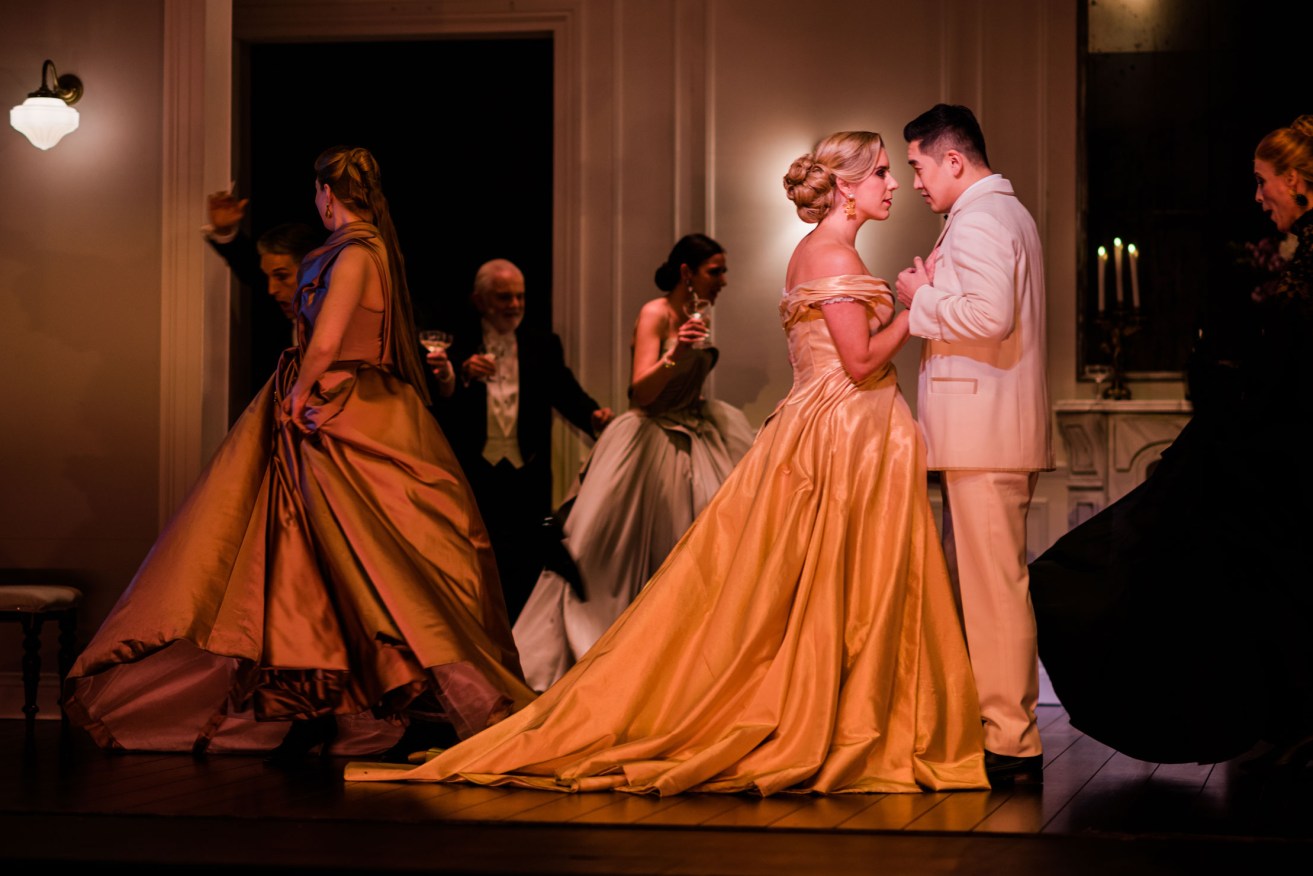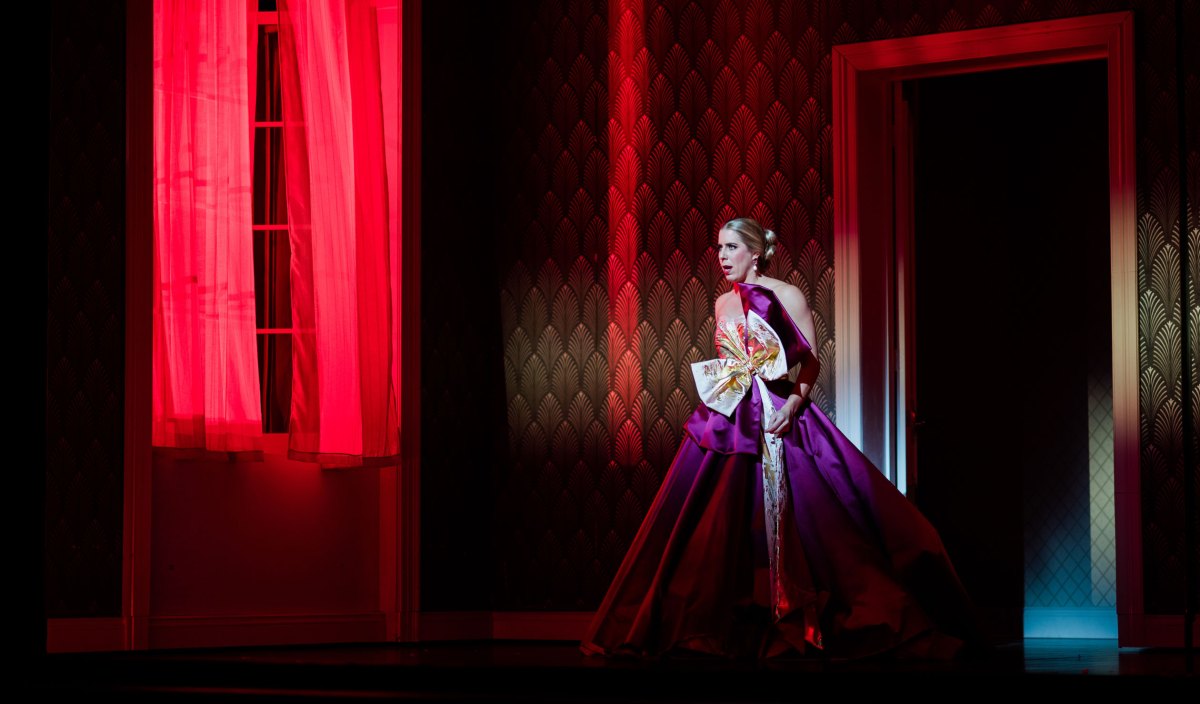Opera review: La Traviata
State Opera’s La Traviata is a beautiful, inspired production that brings a tear to the eye in its exceptionally powerful portrayal of the tragic courtesan, Violetta.


Lauren Fagan as the courtesan Violetta and Kang Wang as her lover Alfredo in State Opera's 'La Traviata'. Photo: That Photography Place
It is not perfect – no production ever is – but Verdi’s masterpiece feels audaciously new all over again in this vivid interpretation by Melbourne director Sarah Giles.
In her own words, Giles has taken a feminist perspective on La Traviata, rescuing Violetta from age-old attitudes that look upon sex workers with a mixture of fascination and condemnation. The potency of the Violetta we encounter in Giles’ production emanates, accordingly, not from what she is but from who she is.
Verdi was revolutionary in centring his opera on a prostitute, depicting her dispassionately for maximum effect on his well-heeled audiences. But Giles throws the emphasis even more sharply on the emotional resolve of the fragile Violetta, who despite fading away in her physical being (from tuberculosis) nevertheless endures forever in spirit.
Spoiler alert here, but be sure to watch carefully what happens in the very final moment, as it is the director’s most creative touch. After a drawn-out dying scene in the typical Italian operatic manner, another figure quickly moves across the stage to take Violetta’s place on her deathbed while Violetta herself arises and walks off ethereally towards the tree of eternity. Best advice: bring a box of tissues.
The slight niggles one might have with this production are mainly questions of emphasis. Violetta, played wonderfully by Lauren Fagan, is notionally a victim who personifies the centuries-old idea of the fallen woman, but who ends up turning things around and gathering the sympathy of all those who reprove her. This production describes the trajectory extremely well. In earlier scenes, though, in Act One, it does not quite ignite: these are the sparkly high-society parties and her retreat to the country with her lover, Alfredo. While it may just have been due to the slight falterings that can happen on opening night, the fabulous parade of arias that roll out in these scenes – all of them among Verdi’s finest – fell short vocally to a degree.
But by jingo, it all took shape in Act Two, when the action begins in earnest. Fagan came into her own with emotional force and gutsy singing of the highest order. A great wave of sympathy spread across the auditorium when she sang, “Alfredo you cannot understand fully the love I have in my heart”.

La Traviata: Two dancers perform a show within a show. Photo: That Photography Place
Kang Wang, who plays Alfredo, rates as a true Verdi tenor and is ideally suited to that role, judging each move with deft precision; and despite the odd strained moment earlier on, he also rose formidably in the second act, especially when he loses his cool during a card game and wrongly accuses Violetta of lying. When at last the two lovers reunite and make up after their clash, a flood of raw emotion flows.
James Roser makes a more placid, understanding Germont than one perhaps usually hears. As Alfredo’s father, he puts up a stern wall of authority in trying to persuade Violetta to end the romance on account of his family’s honour. In this production, Germont puts down his barriers and empathises perhaps too readily with Violetta. But here again, it is a matter of emphasis: this production intentionally seems to throw more attention on Violetta, and this makes it interesting.
The staging went faultlessly on opening night, and there was great artistry in the sets, lighting and costumes. Dividing walls served to separate bedroom from ballroom (there’s one rather private and rather suggestive boudoir scene, so don’t bring your kids), and these walls also accentuate the loss of communication when characters become absorbed in their own thoughts and fail to listen to one another.
At times, the whole cast stops frozen or moves in slow motion as if caught on camera: the look is great and it is impeccably done. Flowing ballroom dresses and smart tunics, inspired by Charles James and Christian Dior designs, are lovely.

Australian soprano Lauren Fagan in La Traviata. Photo: That Photography Place
The supporting characters are all capably sung and the choruses delightfully crisp. Pelham Andrews (as the Baron), Cherie Boogaart (Flora, another courtesan) and Mark Oates (Gastone) are very memorable; Jeremy Tatchell, Teresa La Rocca and Conal Coad are excellent, too. Two dancers offer a terrifically entertaining little show-within-a-show in the second half when Flora holds one of her more riotous parties.
Oliver von Dohnányi guides the Adelaide Symphony Orchestra with sure hands. Not pushing matters, he gives the voices primacy and allows them a full, natural flow that makes for the best Verdi. The stabbing death music at the end is perfectly timed and really puts a gulp in one’s throat.
This is a co-production between State Opera South Australia, Opera Queensland and West Australian Opera, so there is a good resourcing behind it, and it shows. Anyone remotely interested in opera will love this La Traviata. There is much thought behind it, and it really hits the mark.
State Opera South Australia is presenting La Traviata again at Her Majesty’s Theatre on August 27 and 30, and September 1 and 3.




